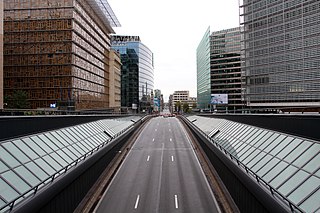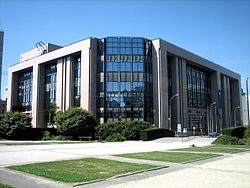
The Council of the European Union, often referred to in the treaties and other official documents simply as the Council, and informally known as the Council of Ministers, is the third of the seven Institutions of the European Union (EU) as listed in the Treaty on European Union. It is one of two legislative bodies and together with the European Parliament serves to amend and approve or veto the proposals of the European Commission, which holds the right of initiative.

The European Council is where EU leaders meet to set EU's political agenda, but they do not pass laws.

Justus Lipsius was a Flemish Catholic philologist, philosopher, and humanist. Lipsius wrote a series of works designed to revive ancient Stoicism in a form that would be compatible with Christianity. The most famous of these is De Constantia. His form of Stoicism influenced a number of contemporary thinkers, creating the intellectual movement of Neostoicism. He taught at the universities in Jena, Leiden, and Leuven.

The Berlaymont building is an office building in Brussels, Belgium, which houses the headquarters of the European Commission, the executive branch of the European Union (EU). The structure is located on the Robert Schuman Roundabout at 200, rue de la Loi/Wetstraat, in what is known as the "European Quarter". The unique form of the Berlaymont's architecture is used in the European Commission's official emblem. The building is named after the Convent of the Ladies of Berlaymont.

Brussels-Schuman railway station is a railway station in the City of Brussels, Belgium, serving the European Quarter. It received its name from the area around the Robert Schuman Roundabout, itself named after Robert Schuman, one of the founding fathers of the European Union.

Maelbeek or Maalbeek is a Brussels Metro station in the City of Brussels, Belgium. Its name originates from the Maalbeek stream.

The Rue de la Loi or Wetstraat (Dutch), meaning "Law Street", is a major street running through central and eastern Brussels, Belgium, which is famous due to the presence of several notable Belgian and European Union (EU) governmental buildings. The road runs from the Rue Royale/Koningsstraat, in central Brussels, to the Robert Schuman Roundabout in its European Quarter. It forms the first (westerly) part of the N3 road that runs to Aachen, Germany.
The Résidence Palace -International Press Center (IPC) is a facility, hub and venue for international journalists located in Brussels, Belgium. The IPC was founded on an initiative by the Belgian Federal Government to improve its media capabilities. It is an autonomous service of the General-Directorate for External Communications, which reports back to the Prime Minister's office. It is based in Bloc-C of the Résidence Palace, a 1920s Art Deco building, on Rue de la Loi. The location was chosen for its close proximity to Belgian Federal Ministries, and EU institutions. Since 2017, the seat of the European Council and Council of the European Union, frequented by high-profile European politicians for international summits, is based adjacent to the premises, in the Europa building. The opening of the press centre coincided with the start of the Belgian Presidency of the Council of the EU on 2 July 2001.
The seven institutions of the European Union (EU) are seated in four different cities, which are Brussels (Belgium), Frankfurt am Main (Germany), Luxembourg (Luxembourg) and Strasbourg (France), rather than being concentrated in a single capital city. All four were chosen, among various reasons, for their location halfway between France and Germany, the countries whose rivalry led to two World Wars and whose reconciliation paved the way for European integration. The EU agencies and other bodies are located all across the union, but usually not fixed in the treaties. The Hague is the only exception, as the fixed seat of the Agency for Law Enforcement Cooperation (Europol). Luxembourg City is the EU capital that can lay claim to having the most of the seven EU institutions based wholly or partly upon its territory, with only the European Council and European Central Bank not having a presence in the city. Over the years, Brussels has become the EU's political hub, with the College of the Commissioners – the European Commission's politically accountable executive – and the European Council both meeting at their Brussels-based headquarters, and the European Parliament and Council of the EU holding the majority of their meetings annually within the city. This has led media to describe it as the de facto "capital of the EU".

Brussels (Belgium) is considered the de facto capital of the European Union, having a long history of hosting a number of principal EU institutions within its European Quarter. The EU has no official capital but Brussels hosts the official seats of the European Commission, Council of the European Union, and European Council, as well as a seat of the European Parliament. In 2013, this presence generated about €250 million and 121,000 jobs. The main rationale for Brussels being chosen as "capital the European Union" was its halfway location between France, Germany and the United Kingdom, the three countries whose rivalry played a role in starting the two World Wars and whose reconciliation paved the way for European integration.

The Charlemagne building is a high-rise in the European Quarter of Brussels, Belgium, which houses the Directorate-General for Economic and Financial Affairs, the Directorate-General for Trade, and since 2015, the Internal Audit Service of the Commission. It is named after Holy Roman Emperor Charlemagne.

The Europa building is the seat of the European Council and Council of the European Union, located on the Rue de la Loi/Wetstraat in the European Quarter of Brussels, Belgium. Its defining feature is the multi-storey "lantern-shaped" construct holding the main meeting rooms; a representation of which has been adopted by both the European Council and Council of the EU as their official emblems.

The Robert Schuman Roundabout, sometimes called Robert Schuman Square, is a roundabout at the end of the Rue de la Loi/Wetstraat in Brussels, Belgium, that serves as a focus for major institutions of the European Union (EU). It is named after Robert Schuman, one of the founding fathers of the European Union, and gives its name to the surrounding district and Brussels-Schuman railway station.

The Place Jean Rey is a square in the European Quarter of Brussels, Belgium. It was inaugurated in 2001 and is named after Jean Rey, the second President of the European Commission.

The Lex building is a high-rise of government offices in the European Quarter of Brussels, Belgium. It is an annex building of the Council of the European Union and is located at 145, rue de la Loi/Wetstraat.

The Esplanade of the European Parliament, or simply the Mall, is a pedestrian mall in Brussels, Belgium, completed in 2002. Its most representative parts are the Solidarność 1980 Esplanade and the Simone Veil Agora.

The Jardin de la vallée du Maelbeek (French) or Maalbeekdaltuin (Dutch) is a small green space on the corner of the Rue de la Loi/Wetstraat and the Chaussée d'Etterbeek/Etterbeeksesteenweg at the heart of the European Quarter of Brussels, Belgium. It was inaugurated on 13 May 1951.

Schuman is a Brussels metro station in the City of Brussels, Belgium. It opened as a premetro station on 17 December 1969 and became a full metro station on 20 September 1976, serving former lines 1A and 1B. Following the reorganisation of the Brussels Metro on 4 April 2009, it is served by lines 1 and 5, which cross Brussels from east to west.
The Embassy of the United Kingdom in Brussels is the chief diplomatic mission of the United Kingdom in Belgium. The embassy also represents the British Overseas Territories in Belgium.

The Horizontal Working Party on Drugs is a preparatory body of the Council of the European Union established in 1997, responsible for the lead and management of the work of the council and of the European Union (EU) on drug policy.

















